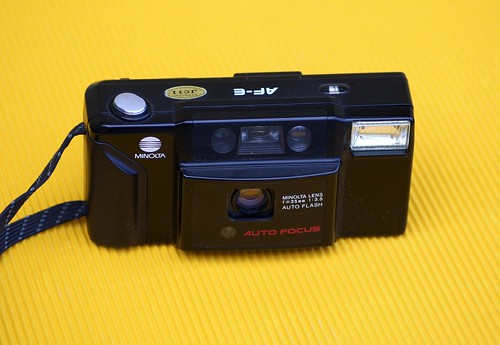Minolta AF-E
| ||
|
In 1984 Minolta presented its fully automatic compact camera Minolta AF-E. In Minolta's 1984 line-up (consisting of the AF-C, AF-S and AF-Sv), it was the "people's camera", with easy loading, automatic flash and a less advanced 1:3.5 f=35mm lens, focused by an active infrared autofocus system. It used DX-coded 35mm film with speeds ISO 100 to 1000. It had automatic exposure and automatic motorized film transport with a mechanical automatic frame counter. The built-in flash was activated automatically in low-light situations by the photo-diode-controlled exposure system. The camera had a reverse Galilean bright frame viewfinder.
Though looking dated now, the AF-E received Japan's "Good Design Award". A limited edition in silver with black accents was also released.
Maginon offered a TW35 accessory optics set for this model, including an auxiliary wide-angle and telephoto adapter. The modules included add-on optics for lens, viewfinder and autofocus.
Specifications
- Lens: 35 mm ƒ/3,5 (4 elements/4 groups). Built-in lens cover.
- Focus: Active autofocus, 0,65 m to infinity.
- Exposure: Programmed exposure from EV 9 to EV 16,2.
- Film speed: Supports DX coded films ISO 100–1000, manual settings for ISO 100/200/400.
- Film transport: Automatic loading, advance and rewind.
- Finder: Bright frame finder. Flash ready light.
- Flash: Built-in, max range at ISO 100 3,60 m. Automatically activated.
- Power: 2 x AA battery.
- Dimensions: 131x65,5x45,5 mm.
- Weight: 245 g.
Links
- Minolta AF-E in Minowiki (German)

|
| With TW35 telephoto and wide-angle accessory optics. image by Uwe Kulick (Image rights) |

